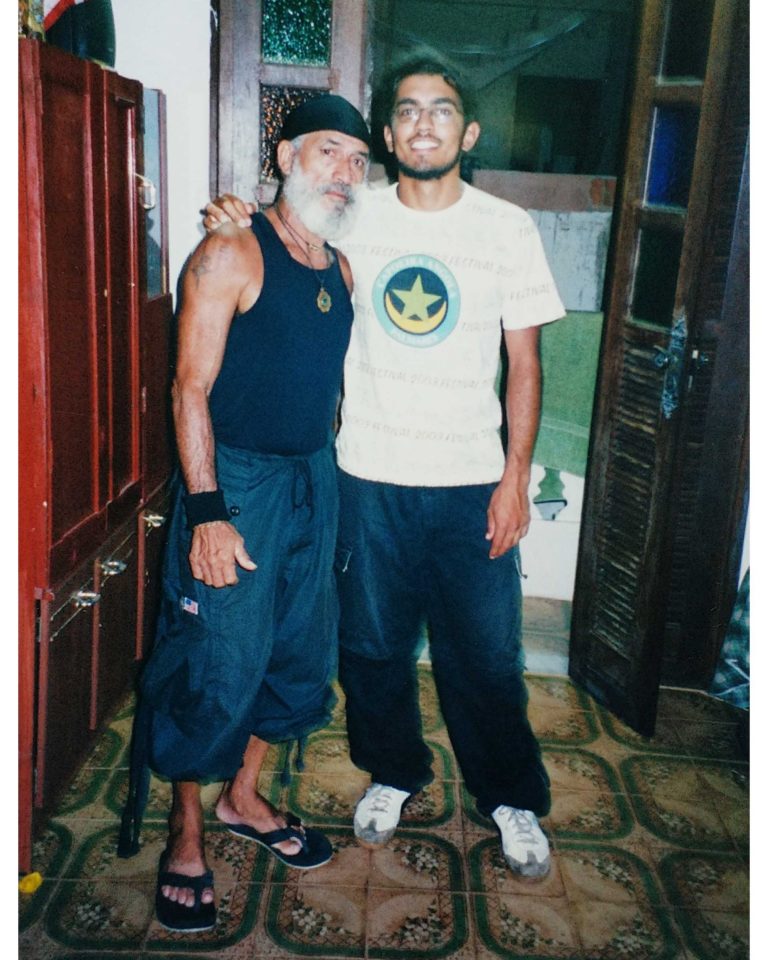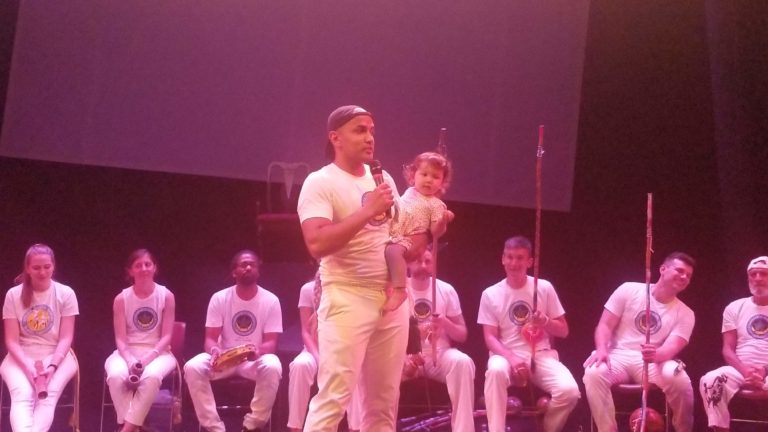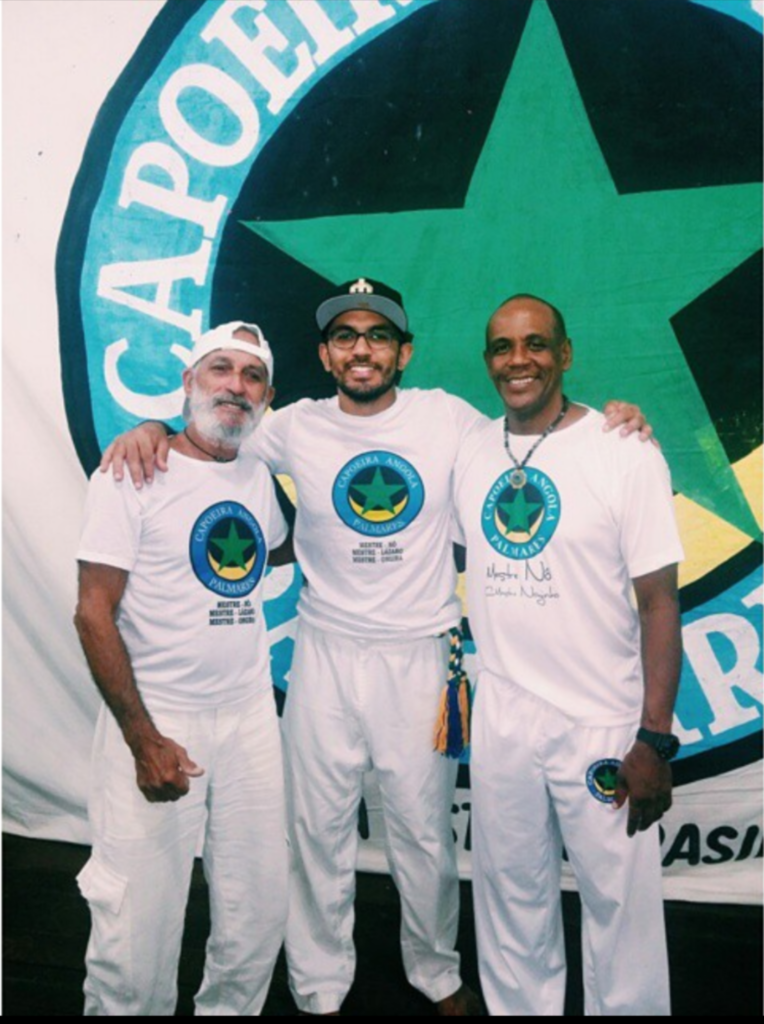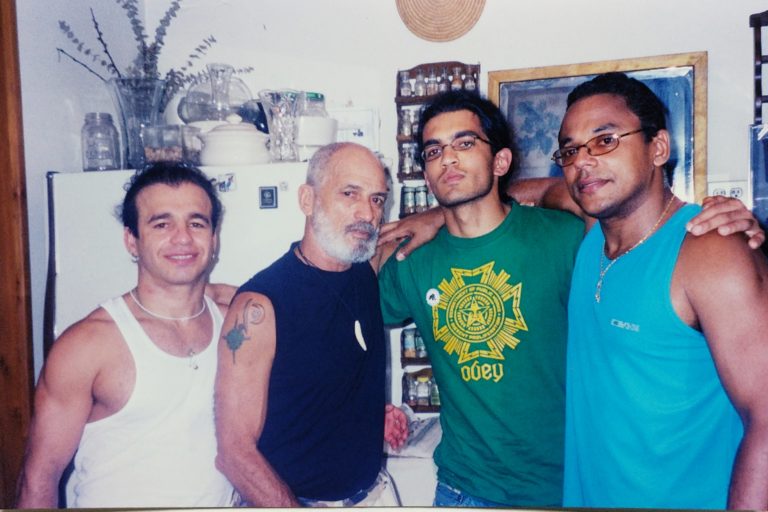Manga’s autobiography
“Oi Mestre, I’m very thankful and appreciative of you always keeping it real and promoting capoeira in Tacoma and Seattle. Also, it’s great you’ve built this online program, giving us access to the masters like you have during this coronavírus shut down… All this variety of capoeira has me more curious about our own history. Can you tell me who are your references, when you graduated to each cord and where you’ve been to in Brazil for my capoeira notes? I have to have this info on my own Mestre.”
– Professor Galo Preto de Angola
Each capoeirista’s lineage, history, and story are the source of their capoeira in the roda and in life. Their choice to commit to a lineage goes both ways because the lineage also chooses its capoeiristas. But a capoeirista without knowledge of their true lineage is a tree without roots, and a tree without roots cannot grow to be wise: facts > knowledge > understanding > experience > wisdom.
So the answer to Professor Galo’s question to Mestre Mangangá (Mes) requires a detailed context of the history. Sharing this history is Mes’s way of expressing gratitude to the source of the capoeira that he wants to instill in his students for our lineage to be carried on.
A Capoeira Life
The Beginnings of My Capoeira
My family was of the very poor working immigrant class in Chicago, and we moved to Seattle when I was 13, six months after my father passed away. The essences of capoeira – resistance, adaptation, and independence (liberation) – were already in me. But my capoeira did not formally begin until I met Mestre Nô, the grand master of our Capoeira Angola Palmares group (aka Grupo Palmares).
I was 14 when my sister tricked me into going to a class with her at Contramestre (CM) Pererê’s Capoeira Angola Palmares Seattle school at the Velocity dance studio on a Saturday. I was amazed by the movements. I never knew people would want to move like that. The unique movements changed my life in a simple way: I became aware of my body in that class. But I knew on my first day that the nature of the games being played and the community at that studio did not resonate with me. It was too soft, clean and polite, and there was no diversity in the group. Regardless, I knew I needed to do capoeira moving forward, so I continued researching and heard Mestre Cobra Mansa was coming to Seattle the following Saturday. Not fully committed to CM Pererê’s group, I wanted to see my options and asked my sister to take me. I was amazed by his dynamic and tough capoeira. Though it inspired me to play and fight capoeira the way that I wanted to, there was still something missing.
The following week, the Mestre dos Mestres was coming to Seattle – Master of Masters… I was intrigued by that title. When I met Mestre Nô, I knew right away I needed to be his student. His swagger and intelligence showed me that you need to play others with style and grace. He knew I did not speak a lick of Portuguese but gestured with his hands that he saw my potential for great heights. He instructed me to learn Português; I was only 14 and 75% illiterate in English, so this has always been a difficult task (grammar in both languages is still a challenge). That weekend, I committed myself to Capoeira Angola Palmares and to Mestre Nô, staying with the same group as my sister. That was only the third week of my capoeira life, and after meeting Mestre Nô, I really began to train. I did not miss a class in 5 years, the exception being when I went to Brazil to play capoeira.
I chose to be Mestre Nô’s disciple from the very beginning, and in return, over time, he chose me. I knew what it meant to be a loyal disciple innately because I grew up with a brother who was a member of a Puerto Rican and Mexican gang in Chicago. Being loyal to my comrades, group and Mestre is second nature to me; anything less would be unacceptable.
After meeting Mestre Nô, we stayed in close contact. A year later, I was in Brazil with my sister living across the street from his home, and, since then, he has hosted me in his home many times. I remember it was his then wife, Dona Sônia (R.I.P.), who named me Manga because she made me mango juice everyday and saying Mangangá was cumbersome for her to say. These memories are the glimpses to the start of my capoeira journey. I can almost answer the question now…
Meu Mestre (My Teacher) and Capoeira References
My Mestre is Mestre Nô. He is more than a teacher to me. He has been the father that I needed.
My main references in capoeira, in no particular order, are Mestres Braulino (R.I.P.), Dindo, Pinóquio, Gerry, Lázaro, and Bigodinho (R.I.P.). References in capoeira are examples of teachers we look to for guidance and different perspectives.
Honorable mentions are Mestres João Pequeno (R.I.P.), Polegar, Naldinho, and Lua Rasta; and CM Pererê
These references are either people I have studied with, lived with and/or played with around the world. There is no YouTube studying here; my experiences are all in the flesh.
Regarding Mestre Braulino in particular, at the time, I was the only North American to have met and trained with him. It was 2010, and he claimed that I was the first North American capoeirista he had met. We hit it off, and he invited me to live with him in Guarujá to train with him. We trained everyday. Mestre Braulino was Mestre Nô’s most infamous disciple. I was determined to learn, and the training was rewarding. Through my desire to be better, I earned Mestre Braulino’s respect and friendship. We stayed in touch until his passing.
Some Of My Capoeira Experiences
I need to point out that I do not do capoeira for the cords or titles. I did what I feel I needed to do in order to live capoeira, and these were the series of events that occurred.
In 2001, Mestre Nô graduated me in Seattle to my first cord – dark green.
Around 2004, Mestre Nô graduated me in Seattle to my second cord – green/yellow.
In 2006, Mestre Nô promoted me in Seattle to Instructor, my third cord – yellow/blue (skipping yellow). Earlier that year, I surprised Mestre Nô on his birthday while he was with Mestres Lincoln and Gulliver in his home in New Jersey. Mestre Nô was blown away and described to the other mestres that I was exactly the type of student that capoeira was lacking in the United States; rather than peer-oriented, I was elder-oriented…I was a loyal disciple. Right then, he instructed me to start my own Palmares school in Seattle and announced that he would promote me to Instructor later that summer.
Many think I splintered off independently, but, actually, Mestre Nô strategically directed me to carry on the Palmares group with a branch unique to me and separate from CM Pererê, though, initially, we also used the name Capoeira Angola Palmares Seattle to follow suit with other Capoeira Angola Palmares schools. Soon after I started our branch at the Lee’s Martial Arts School on Capitol Hill, CM Pererê began to focus on making berimbaus. He makes excellent berimbaus to this day, and I am grateful for the things he shared with me, for introducing me to Mestre Nô and for maintaining Mestre Waldermar da Paixão’s lineage in Seattle for as long as he did. Though CM Pererê’s Seattle branch of Palmares dissolved, I was humbled to have most of their students continue their capoeira with my new program, and we are still maintaining the traditions to this day.
In 2009, on the 30th anniversary of Capoeira Angola Palmares, Mestre Nô wanted to promote me in Florence, Italy, to Professor, my fourth cord – blue. But due to injuries from a car accident, it was not until 2010 at Mestre Dindo’s event in Rio Grande do Sul that I was recognized as Professor by Mestre Nô in the presence of over 500 capoeiristas from across Brazil.
In 2012, we gained a sister school, the Tacoma Group (now WCC Tacoma Capoeira Center), founded and led by Professor Galo Preto de Angola. Professor Galo had been training capoeira since 2003 and is the first angoleiro to teach in Tacoma, WA.
In 2014, I opened our first brick and mortar space and gave our studio its name, the Seattle Capoeira Center. I also officially created our Non-Profit Organization, Capoeira Life, to streamline our social-justice work and to support our capoeira teaching artists.
In 2015, Mestre Nô surprised me with a promotion to Contramestre (CM), my fifth cord – green/yellow/blue/white, at the Palmares Event in the Amazonian city of Boa Vista of Roraima, Brazil. There, I played many African and Native Brazilians. I had never been more intimidated; the surprise was thrilling. During the event, Mestre Nô, like a true mandingueiro, diverted my attention, telling me he was planning to promote me to CM in front of my students in Seattle, but he gave me a rasteira that would change my life when he called my name for the CM promotion.
Later in 2015, my brother-in-law and founder of the Seattle Black Panther Party, Aaron Dixon, and I created Panteras dos Palmares to distinguish our school’s social and racial justice initiatives within the Capoeira Angola Palmares association.
In 2017, my daughter, Aafiya, was born, a new source of love, inspiration and motivation. Aafiya is my mestre in life, no joke. Earlier in the year, I transitioned our group to the umbrella name, the Washington Capoeira Center (WCC).
In 2019, the 40th year of Capoeira Angola Palmares, Mestre Nô promoted me in Seattle to Mestre with my fifth cord – white/green. I was grateful to be promoted alongside my students’ graduations at our annual batizado in the presence of a full audience of over 300 friends, family and community members. I became the second North American acknowledged as a mestre by Mestre Nô in his 30 years of teaching in the United States. In an international sense, I am the first South Asian (Indian) mestre of capoeira.
Today, we are expanding the boundaries of our students, developing online programs to train live with our local instructors as well as with mestres across Brazil (and Europe in the plans). This new milestone is allowing us to full-circle and contribute back to the source mestres of our capoeira.
Apart from playing across the United States, and in Europe, Asia and Africa, I have played the most in Brazil: Rio Grande do Sul, Santa Catarina, São Paulo, Rio de Janeiro, Minas Gerais, Espírito Santo, Brasília (Capitol), Goiana, Bahia, Sergipe, Amazonas, Pernambuco, Paraíba and Roraima
Our Capoeira Life
It has always felt natural for me to take the “capoeira life” versus the “conventional/normal life”, and the source of my choice is to maintain our lineage in Seattle, a lineage that is a combination of Mestres Zeca do Uruguai and Waldemar da Paixão. As a member of the Washington Capoeira Center, you each have chosen the “capoeira path”. It can be applied to all lives at any point, and it is not one or the other (capoeira or “normal”); it is your own adaptation of their combination. Be true to yourself and to capoeira.
Without all of you, including parents of the children in the group, I would not have had anything to be promoted for. Mestre Nô formed me into a Mestre of Capoeira Angola with the purpose of carrying on our lineage through the students. It is because of you all in Seattle and Tacoma that we are the oldest group of Capoeira Angola Palmares outside of Brazil. I am determined to continue bringing the group to new heights, and I could not do it without all of your commitment, help and axé. Vamos trabalhar… we have a lot of work to do. It is thrilling and exciting, and I am grateful to have you all alongside me. Our capoeira lives are just beginning.
-manga



